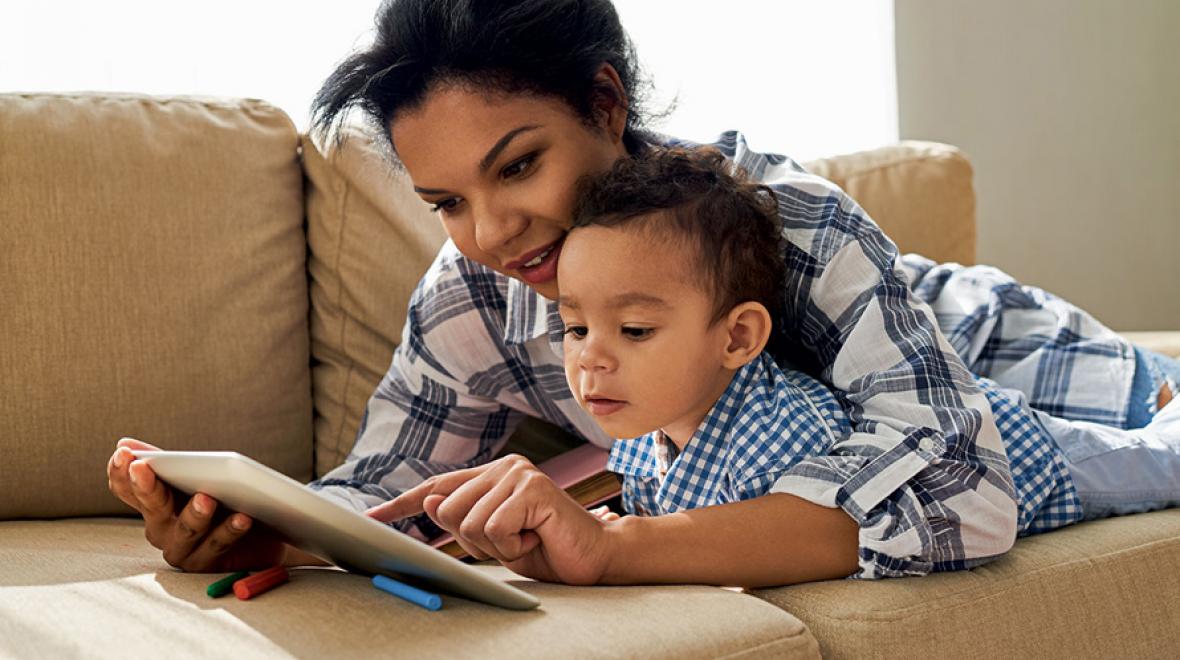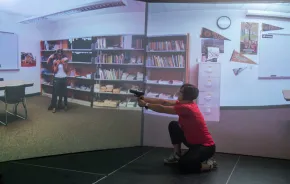
Before my kids were born, I couldn’t imagine giving them iPads instead of crayons. I was certain they’d spend long summer days building tree forts and decorating the sidewalk with chalk creations. What I didn’t expect was that they’d do all that and still bug me to use the iPad.
As much as I declare myself a free-range mom and embrace the concept of “playborhoods," I’ve also come to deeply appreciate the value of a little screen time. Our kids aren’t growing up in the same world we did; they’re expected to be tech-savvy problem-solvers. So, while ditching screen time entirely feels impractical, it’s hard to know how and where tech fits in. Is there such a thing as “good” tech play?
The (perhaps surprising) answer: Yes. A study published in the September 2014 issue of Pediatrics found that adolescents who play low levels of video games (less than one hour per day) had higher levels of life satisfaction, were more interested in social interaction and less likely to report ineffective methods for coping with their problems than their peers who didn’t play video games.
Adolescents who play high levels of video games (more than three hours per day) had the opposite results. Kids who fell in the middle — playing video games between one and three hours per day — experienced no differences from their video-game-free peers. So, while moderate video game play doesn’t appear to pose a threat to their development, kids who forgo video games entirely may be missing out.
Results like these buck the trends of prioritizing off-line play or viewing screen time with concern. Much of this concern has its roots in earlier studies about the impact of technology on kids that focused on passive forms of entertainment, like television, which present different risks and benefits from the interactive games most kids now play. Those earlier studies led to recommendations for parents to strictly limit their kids’ screen time, or even avoid screens entirely.
It’s important for parents to interact with their children as they play in order for them to get the most benefit.
Screen time recommendations have since loosened; the American Academy of Pediatrics recommends that children younger than 5 limit screen time to one hour per day, and parents of school-age children are advised to enforce consistent screen time limits, rather than strictly setting a total number of hours.
“Balance is the key. You wouldn’t encourage a child to spend their entire day assembling puzzles at the expense of social interactions with peers,” says Richard Shuster, Psy.D., MSW, a clinical psychologist whose doctoral dissertation focused on technology and personality functioning. “The fact is that there are countless apps and games that encourage prosocial development, learning and development of fine motor skills. It isn’t an all-or-nothing proposition.”
The type of games kids play also matters. Games don’t always look like they’re educating kids, but a number of studies have demonstrated that kids are more engaged when they play games that leverage interactive aspects and encourage players to make choices. One study published in the May 2014 edition of Computers & Education found that kids learned more when they played interactive reading games than when they played the same game but skipped the interactive activity — a result contrary to some educators’ concerns that such activities detract or distract from learning.
Sierra Corbin is a speech-language pathologist. She says selecting quality interactive games for kids can help them develop healthy social and language skills. Even young kids can use apps, such as “Wheels on the Bus,” which rely on simple interactive elements like touching the screen to make something happen.
“This develops an understanding of cause-effect relationships, improves language by having the child ask, ‘Can I open the yellow doors?’ and facilitates the learning of concepts such as colors, shapes and feelings,” Corbin says. With toddlers and young children, it’s important for their parents to interact with them as they play in order for them to get the most benefit.
In her practice, Corbin also uses the “Maker” app, which lets kids put ingredients in a bowl and touch the screen to “cook” various items, such as pancakes. “Kids love to choose the different ingredients, and it lets me control what they work on,” she says. “For instance, if we are working on prepositions, I ask where the ingredient is going to go, ‘On top or inside?’” Kids are so busy having fun that they don’t realize they’re learning.
Much like the games Corbin uses, many of the most popular kids’ games (such as Minecraft and Pokémon Go) are highly interactive and encourage kids to explore. This explains their popularity and may also be the reason why kids are so loath to set devices down. University of Washington researchers found that giving kids a two-minute warning that screen time was about to end actually made tantrums worse while forming routines for screen time or leveraging a natural stopping point in the game eased the transition.
Like it or not, screens are here to stay. For parents like me who want their kids to explore everything the world has to offer, including technology, the takeaway is clear — screen time isn’t the enemy. But it might be time to say goodbye to passive screen time in favor of interactive games that pack a one-two punch for intellectual and emotional development.
High-tech ways to playMy own kids can’t get enough of Bitsbox, a subscription service that teaches even young children how to code their own apps. Using instruction cards to create different apps every month, kids can build on their knowledge and experiment by combining different code elements to develop new app-based experiences. Circuit Cubes are battery-powered building cubes that turn everything from Legos to household items, like toilet paper tubes, into inventions. By combining battery cubes with motorized or LED cubes, kids can build a seemingly endless number of unique creations while learning about electricity — and without electrocuting themselves. While virtual reality (VR) is primarily designed for entertainment, Tim Lynch, Ph.D., a psychologist who specializes in how computer interaction affects personality, says one of the benefits of VR for kids is the ability to practice new skills, like sports, without risking negative feedback from peers. Plus, because our brains can’t distinguish between experiences that occur in VR or in the real world, the tool allows kids to experience things that they’d otherwise not be able to, such as running the Boston Marathon or biking the Tour de France. Technically a video game, Pokémon Go offers a unique style of play that gets kids exploring in search of rare Pokémon to add to their Pokédex. It also presents a challenge for parents concerned about their kids wandering off. However, a 2015 International Journal of Environmental Research and Public Health study found that risky play (which includes the threat of kids getting lost while exploring through play) is critical for healthy development. If you can’t stomach the risk (or your kids are too young to roam on their own), it’s also a great way for parents and kids to have fun with technology together. Consider remote-controlled cars, trucks or even drones for bonding time. Whether simply operating your vehicles together, creating elaborate obstacle courses or hooking up your vehicles with GoPro cameras and filming your adventures, both kids and parents will have fun finding new ways to play (and crash!) together. |











